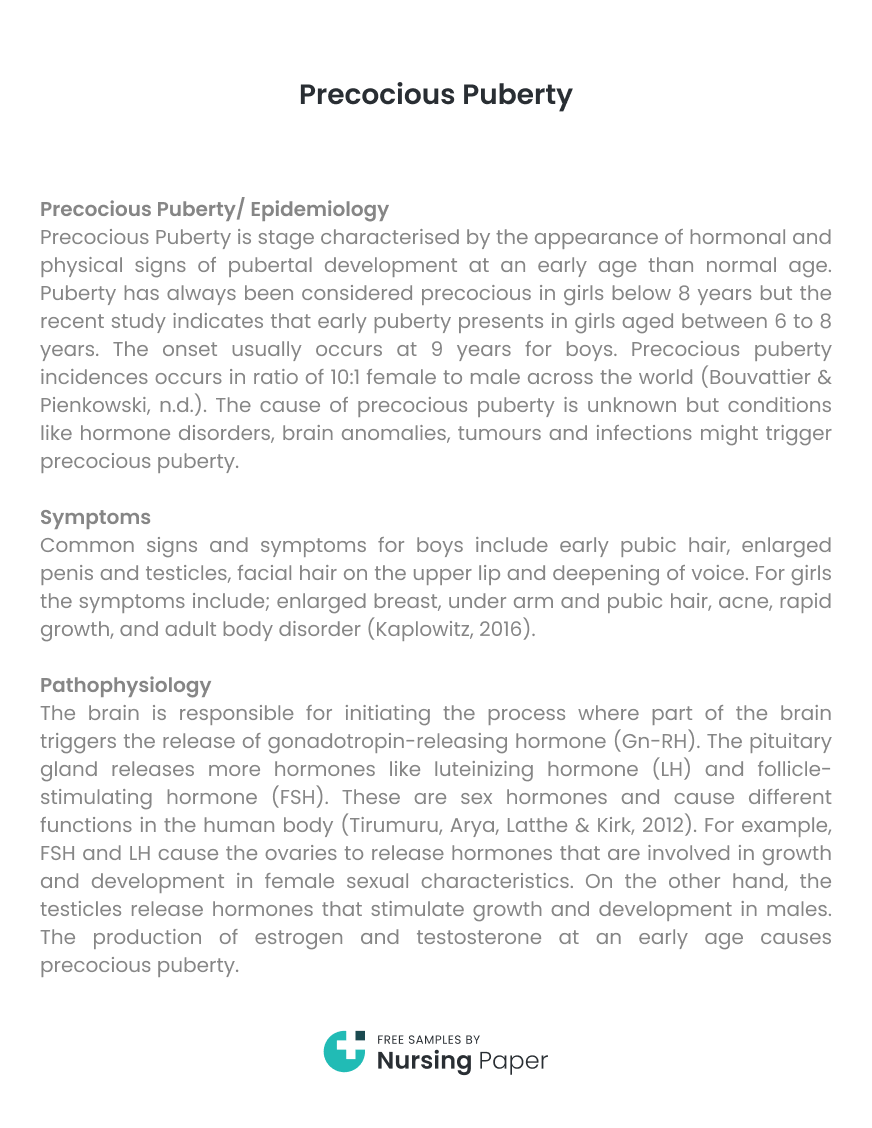
Precocious Puberty
Precocious Puberty/Epidemiology
Precocious Puberty is stage characterised by the appearance of hormonal and physical signs of pubertal development at an early age than normal age. Puberty has always been considered precocious in girls below 8 years but the recent study indicates that early puberty presents in girls aged between 6 to 8 years. The onset usually occurs at 9 years for boys. Precocious puberty incidences occurs in ratio of 10:1 female to male across the world (Bouvattier & Pienkowski, n.d.). The cause of precocious puberty is unknown but conditions like hormone disorders, brain anomalies, tumours and infections might trigger precocious puberty.
Symptoms
Common signs and symptoms for boys include early pubic hair, enlarged penis and testicles, facial hair on the upper lip and deepening of voice. For girls the symptoms include; enlarged breast, under arm and pubic hair, acne, rapid growth, and adult body disorder (Kaplowitz, 2016).


Pathophysiology
The brain is responsible for initiating the process where part of the brain triggers the release of gonadotropin-releasing hormone (Gn-RH). The pituitary gland releases more hormones like luteinizing hormone (LH) and follicle-stimulating hormone (FSH). These are sex hormones and cause different functions in the human body (Tirumuru, Arya, Latthe & Kirk, 2012). For example, FSH and LH cause the ovaries to release hormones that are involved in growth and development in female sexual characteristics. On the other hand, the testicles release hormones that stimulate growth and development in males. The production of estrogen and testosterone at an early age causes precocious puberty.
Diagnosis
Diagnosis procedure involves conducting a physical exam, reviewing the child’ and family medical history, and running blood tests to measure hormone levels. Physical examination is important because the physician can assess for early pubic hair, adult odor, enlarged breasts, deepening of voices and under arm hair. X rays are recommended because they help doctors to determine the child’s bone age (Saggese, 2013). Other tests include Magnetic resonance imaging (MRI) to detect brain anomalies, thyroid tests to detect the hyper or hypothyroidism.
Differential Diagnosis
Autonomous endocrine hyperfuction polyostotic fibrous dysplasia, neurofibromas, axillary freckling, and kyphoscoliosis

Treatment
Treatment is done based on the causes; for example, the use of Gn-RH analogue therapy is given monthly as an injection (Lupron Depot). The medication is given until the child attain normal puberty age (Tirumuru, Arya, Latthe & Kirk, 2012). Surgery can be done to remove tumors that result to production of hormones that trigger precocious puberty.
Children with precocious puberty often feel different compared to their peers, which can cause emotional and social problems. It is important to introduce psychological counselling to help the family and the child to cope with the condition.
1. Bouvattier, C., & Pienkowski, C. Early puberty.
2. Butler, G. (2017). Precocious puberty and its variants. Endocrine Abstracts. doi: 10.1530/endoabs.51.cme6
3. Kaplowitz, P. (2016). Early puberty in girls. New York: Ballantine Books.
4. Precocious Puberty (Early Puberty): Your Child: University … Retrieved from http://www.med.umich.edu/yourchild/topics/puberty.htm
5. Precocious puberty | Genetic and Rare Diseases Information … Retrieved from https://rarediseases.info.nih.gov/diseases/7446/precocious-puberty
6. Saggese, G. (2013). European conference, diagnosis on treatment of central precocious puberty. London, England: Freund Pub. House Ltd.
7. Tirumuru, S., Arya, P., Latthe, P., & Kirk, J. (2012). Understanding precocious puberty in girls. The Obstetrician & Gynaecologist, 14(2), 121-129. doi: 10.1111/j.1744-4667.2012.00094.x



The download will start shortly.

The download will start shortly.
 Subject:
Health and Social Care
Subject:
Health and Social Care  Number of pages: 4
Number of pages: 4  Subject:
Health and Social Care
Subject:
Health and Social Care  Number of pages: 2
Number of pages: 2  Subject:
Health and Social Care
Subject:
Health and Social Care  Number of pages: 4
Number of pages: 4  Subject:
Health and Social Care
Subject:
Health and Social Care  Number of pages: 5
Number of pages: 5  Subject:
Medicine
Subject:
Medicine  Number of pages: 3
Number of pages: 3  Subject:
Health and Social Care
Subject:
Health and Social Care  Number of pages: 2
Number of pages: 2  Subject:
Nursing
Subject:
Nursing  Number of pages: 16
Number of pages: 16  Subject:
Medicine
Subject:
Medicine  Number of pages: 2
Number of pages: 2  Subject:
Medicine
Subject:
Medicine  Number of pages: 18
Number of pages: 18  Subject:
Medicine
Subject:
Medicine  Number of pages: 6
Number of pages: 6  Subject:
Health and Social Care
Subject:
Health and Social Care  Number of pages: 5
Number of pages: 5  Subject:
Health and Social Care
Subject:
Health and Social Care  Number of pages: 2
Number of pages: 2  Subject:
Health and Social Care
Subject:
Health and Social Care  Number of pages: 19
Number of pages: 19  Subject:
Medicine
Subject:
Medicine  Number of pages: 5
Number of pages: 5  Subject:
Health and Social Care
Subject:
Health and Social Care  Number of pages: 2
Number of pages: 2 
